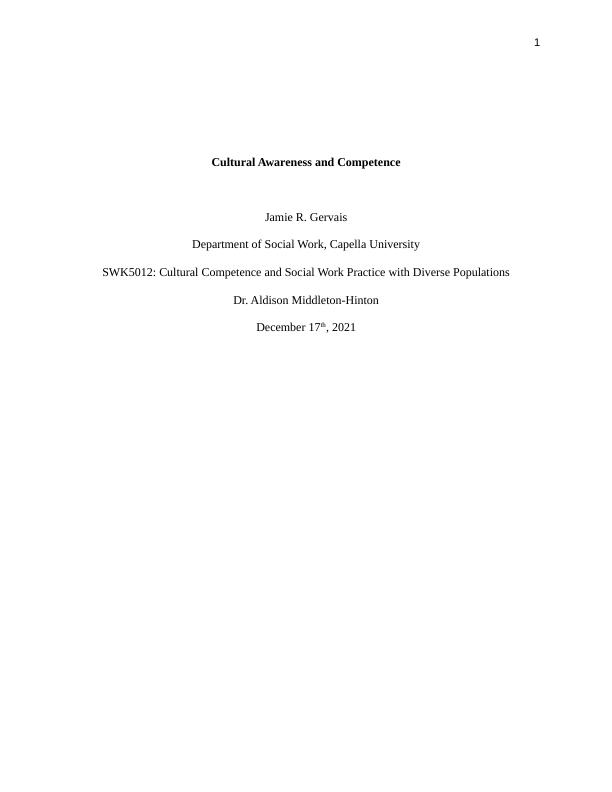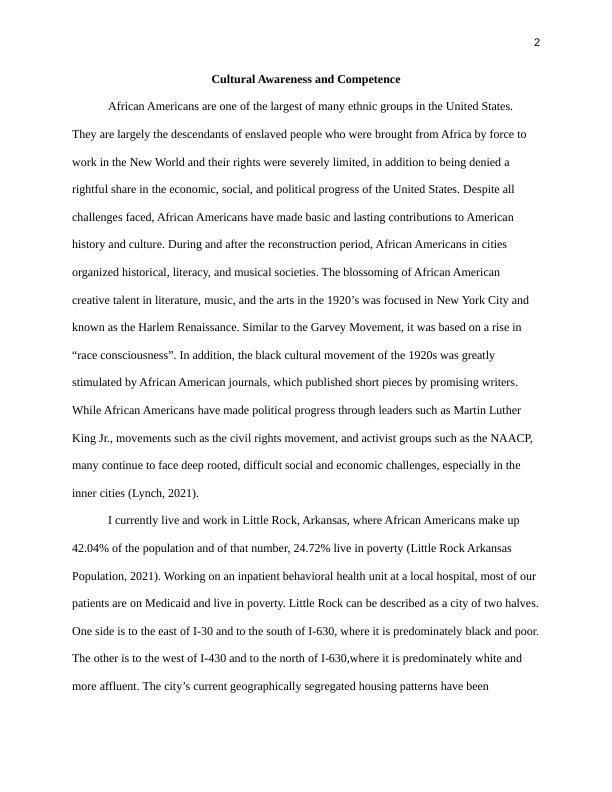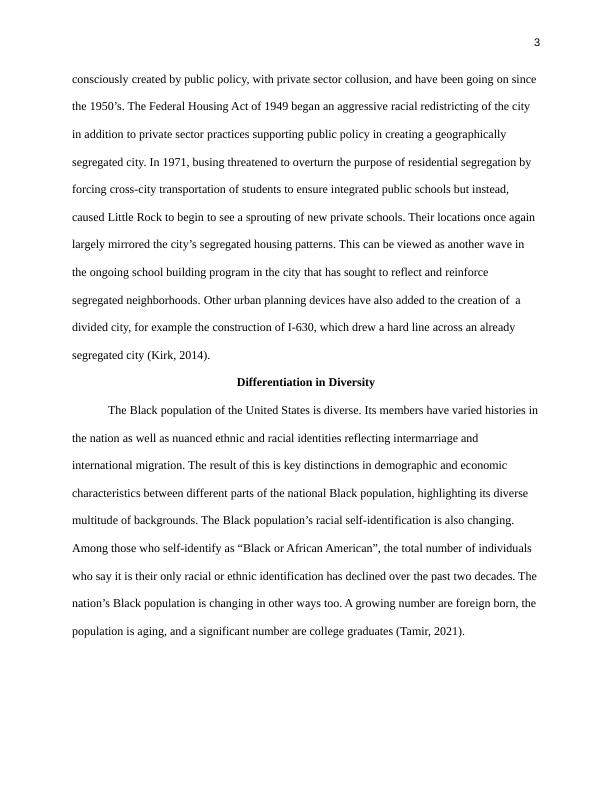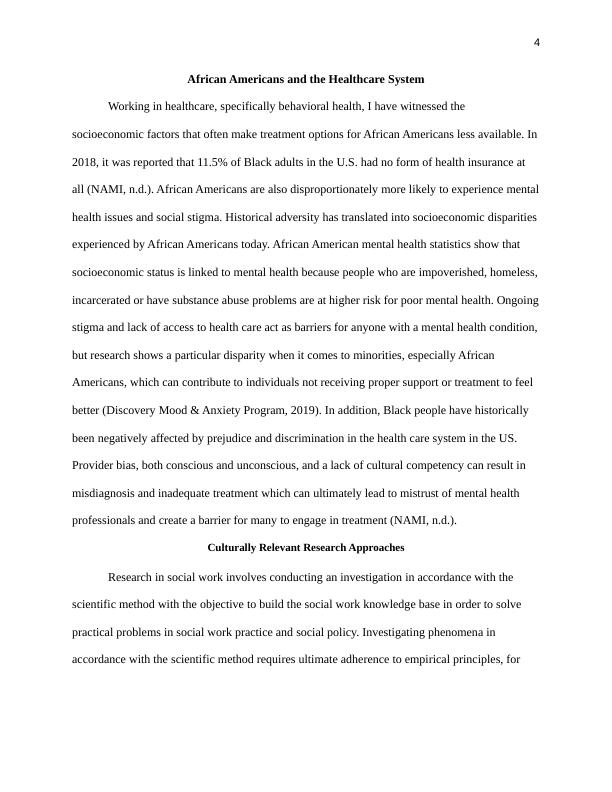Cultural Awareness and Competence of Jamie R. Gervais Department
17 Pages4779 Words32 Views
Added on 2022-03-15
About This Document
African Americans and the Healthcare System, Culturally Relevant Research Approaches, and Culturally Competent Strategies for Recruitment and Retention of African American Populations into Clinical Trials are some of the topics that will be covered in the document that is provided below, which is based on the Cultural Awareness and Competence. Additionally included in the paper are some practical principles, culturally sensitive research methodologies, social justice issues, and theories and methodologies. Below is also a discussion of technological communications and action plans.
Cultural Awareness and Competence of Jamie R. Gervais Department
Added on 2022-03-15
ShareRelated Documents
1
Cultural Awareness and Competence
Jamie R. Gervais
Department of Social Work, Capella University
SWK5012: Cultural Competence and Social Work Practice with Diverse Populations
Dr. Aldison Middleton-Hinton
December 17th, 2021
Cultural Awareness and Competence
Jamie R. Gervais
Department of Social Work, Capella University
SWK5012: Cultural Competence and Social Work Practice with Diverse Populations
Dr. Aldison Middleton-Hinton
December 17th, 2021

2
Cultural Awareness and Competence
African Americans are one of the largest of many ethnic groups in the United States.
They are largely the descendants of enslaved people who were brought from Africa by force to
work in the New World and their rights were severely limited, in addition to being denied a
rightful share in the economic, social, and political progress of the United States. Despite all
challenges faced, African Americans have made basic and lasting contributions to American
history and culture. During and after the reconstruction period, African Americans in cities
organized historical, literacy, and musical societies. The blossoming of African American
creative talent in literature, music, and the arts in the 1920’s was focused in New York City and
known as the Harlem Renaissance. Similar to the Garvey Movement, it was based on a rise in
“race consciousness”. In addition, the black cultural movement of the 1920s was greatly
stimulated by African American journals, which published short pieces by promising writers.
While African Americans have made political progress through leaders such as Martin Luther
King Jr., movements such as the civil rights movement, and activist groups such as the NAACP,
many continue to face deep rooted, difficult social and economic challenges, especially in the
inner cities (Lynch, 2021).
I currently live and work in Little Rock, Arkansas, where African Americans make up
42.04% of the population and of that number, 24.72% live in poverty (Little Rock Arkansas
Population, 2021). Working on an inpatient behavioral health unit at a local hospital, most of our
patients are on Medicaid and live in poverty. Little Rock can be described as a city of two halves.
One side is to the east of I-30 and to the south of I-630, where it is predominately black and poor.
The other is to the west of I-430 and to the north of I-630,where it is predominately white and
more affluent. The city’s current geographically segregated housing patterns have been
Cultural Awareness and Competence
African Americans are one of the largest of many ethnic groups in the United States.
They are largely the descendants of enslaved people who were brought from Africa by force to
work in the New World and their rights were severely limited, in addition to being denied a
rightful share in the economic, social, and political progress of the United States. Despite all
challenges faced, African Americans have made basic and lasting contributions to American
history and culture. During and after the reconstruction period, African Americans in cities
organized historical, literacy, and musical societies. The blossoming of African American
creative talent in literature, music, and the arts in the 1920’s was focused in New York City and
known as the Harlem Renaissance. Similar to the Garvey Movement, it was based on a rise in
“race consciousness”. In addition, the black cultural movement of the 1920s was greatly
stimulated by African American journals, which published short pieces by promising writers.
While African Americans have made political progress through leaders such as Martin Luther
King Jr., movements such as the civil rights movement, and activist groups such as the NAACP,
many continue to face deep rooted, difficult social and economic challenges, especially in the
inner cities (Lynch, 2021).
I currently live and work in Little Rock, Arkansas, where African Americans make up
42.04% of the population and of that number, 24.72% live in poverty (Little Rock Arkansas
Population, 2021). Working on an inpatient behavioral health unit at a local hospital, most of our
patients are on Medicaid and live in poverty. Little Rock can be described as a city of two halves.
One side is to the east of I-30 and to the south of I-630, where it is predominately black and poor.
The other is to the west of I-430 and to the north of I-630,where it is predominately white and
more affluent. The city’s current geographically segregated housing patterns have been

3
consciously created by public policy, with private sector collusion, and have been going on since
the 1950’s. The Federal Housing Act of 1949 began an aggressive racial redistricting of the city
in addition to private sector practices supporting public policy in creating a geographically
segregated city. In 1971, busing threatened to overturn the purpose of residential segregation by
forcing cross-city transportation of students to ensure integrated public schools but instead,
caused Little Rock to begin to see a sprouting of new private schools. Their locations once again
largely mirrored the city’s segregated housing patterns. This can be viewed as another wave in
the ongoing school building program in the city that has sought to reflect and reinforce
segregated neighborhoods. Other urban planning devices have also added to the creation of a
divided city, for example the construction of I-630, which drew a hard line across an already
segregated city (Kirk, 2014).
Differentiation in Diversity
The Black population of the United States is diverse. Its members have varied histories in
the nation as well as nuanced ethnic and racial identities reflecting intermarriage and
international migration. The result of this is key distinctions in demographic and economic
characteristics between different parts of the national Black population, highlighting its diverse
multitude of backgrounds. The Black population’s racial self-identification is also changing.
Among those who self-identify as “Black or African American”, the total number of individuals
who say it is their only racial or ethnic identification has declined over the past two decades. The
nation’s Black population is changing in other ways too. A growing number are foreign born, the
population is aging, and a significant number are college graduates (Tamir, 2021).
consciously created by public policy, with private sector collusion, and have been going on since
the 1950’s. The Federal Housing Act of 1949 began an aggressive racial redistricting of the city
in addition to private sector practices supporting public policy in creating a geographically
segregated city. In 1971, busing threatened to overturn the purpose of residential segregation by
forcing cross-city transportation of students to ensure integrated public schools but instead,
caused Little Rock to begin to see a sprouting of new private schools. Their locations once again
largely mirrored the city’s segregated housing patterns. This can be viewed as another wave in
the ongoing school building program in the city that has sought to reflect and reinforce
segregated neighborhoods. Other urban planning devices have also added to the creation of a
divided city, for example the construction of I-630, which drew a hard line across an already
segregated city (Kirk, 2014).
Differentiation in Diversity
The Black population of the United States is diverse. Its members have varied histories in
the nation as well as nuanced ethnic and racial identities reflecting intermarriage and
international migration. The result of this is key distinctions in demographic and economic
characteristics between different parts of the national Black population, highlighting its diverse
multitude of backgrounds. The Black population’s racial self-identification is also changing.
Among those who self-identify as “Black or African American”, the total number of individuals
who say it is their only racial or ethnic identification has declined over the past two decades. The
nation’s Black population is changing in other ways too. A growing number are foreign born, the
population is aging, and a significant number are college graduates (Tamir, 2021).

4
African Americans and the Healthcare System
Working in healthcare, specifically behavioral health, I have witnessed the
socioeconomic factors that often make treatment options for African Americans less available. In
2018, it was reported that 11.5% of Black adults in the U.S. had no form of health insurance at
all (NAMI, n.d.). African Americans are also disproportionately more likely to experience mental
health issues and social stigma. Historical adversity has translated into socioeconomic disparities
experienced by African Americans today. African American mental health statistics show that
socioeconomic status is linked to mental health because people who are impoverished, homeless,
incarcerated or have substance abuse problems are at higher risk for poor mental health. Ongoing
stigma and lack of access to health care act as barriers for anyone with a mental health condition,
but research shows a particular disparity when it comes to minorities, especially African
Americans, which can contribute to individuals not receiving proper support or treatment to feel
better (Discovery Mood & Anxiety Program, 2019). In addition, Black people have historically
been negatively affected by prejudice and discrimination in the health care system in the US.
Provider bias, both conscious and unconscious, and a lack of cultural competency can result in
misdiagnosis and inadequate treatment which can ultimately lead to mistrust of mental health
professionals and create a barrier for many to engage in treatment (NAMI, n.d.).
Culturally Relevant Research Approaches
Research in social work involves conducting an investigation in accordance with the
scientific method with the objective to build the social work knowledge base in order to solve
practical problems in social work practice and social policy. Investigating phenomena in
accordance with the scientific method requires ultimate adherence to empirical principles, for
African Americans and the Healthcare System
Working in healthcare, specifically behavioral health, I have witnessed the
socioeconomic factors that often make treatment options for African Americans less available. In
2018, it was reported that 11.5% of Black adults in the U.S. had no form of health insurance at
all (NAMI, n.d.). African Americans are also disproportionately more likely to experience mental
health issues and social stigma. Historical adversity has translated into socioeconomic disparities
experienced by African Americans today. African American mental health statistics show that
socioeconomic status is linked to mental health because people who are impoverished, homeless,
incarcerated or have substance abuse problems are at higher risk for poor mental health. Ongoing
stigma and lack of access to health care act as barriers for anyone with a mental health condition,
but research shows a particular disparity when it comes to minorities, especially African
Americans, which can contribute to individuals not receiving proper support or treatment to feel
better (Discovery Mood & Anxiety Program, 2019). In addition, Black people have historically
been negatively affected by prejudice and discrimination in the health care system in the US.
Provider bias, both conscious and unconscious, and a lack of cultural competency can result in
misdiagnosis and inadequate treatment which can ultimately lead to mistrust of mental health
professionals and create a barrier for many to engage in treatment (NAMI, n.d.).
Culturally Relevant Research Approaches
Research in social work involves conducting an investigation in accordance with the
scientific method with the objective to build the social work knowledge base in order to solve
practical problems in social work practice and social policy. Investigating phenomena in
accordance with the scientific method requires ultimate adherence to empirical principles, for

End of preview
Want to access all the pages? Upload your documents or become a member.
Related Documents
Explore South Africa: A Country Researchlg...
|8
|2260
|100
